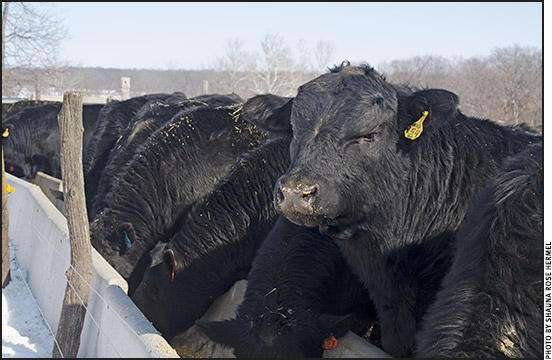HEALTH & NUTRITION...

Feedstuff Considerations
for Feeding Bulls
Choosing from the array of feedstuffs available for feeding and developing bulls can be challenging for many beef cattle producers. The feed industry, popular press and other cattlemen often offer conflicting advice about feedstuffs or their ingredients. Questions arise about the utilization of specific feeds, anti-quality components of some feeds and the mineral program that is best. In the final analysis, however, there is no single perfect feedstuff for feeding bulls, and all feedstuffs can have a place in a well-balanced diet.
What are good feeds to develop and manage bulls? Read more.
Added Enzymes Reduce Costly Bloat Losses
A Texas A&M University researcher works to reduce severity of frothy bloat.
A Texas A&M AgriLife Research animal nutritionist is trying to decrease the severity of frothy bloat, the major nonpathogenic cause of death and reduced performance in cattle grazing hard red winter wheat in the Southern Great Plains. Bill Pinchak of Vernon, Texas, head of the Bloat Research Project, has spent eight years developing intervention strategies to mitigate direct bloat impacts, while enhancing performance in non-bloated animals.
Pinchak said frothy bloat is a costly disease, with an estimated $40 million negative impact on the beef cattle industry. The bloat occurs when a polysaccharide biofilm coats the contents of the rumen. When it comes in contact with fluid and rumen contents, the fermentative gases are trapped and the animal is prevented from belching the excess gas, he said. Read more.

Rick Rasby
Ridin’ Herd
What if the drought continues?
Hopefully, spring turnout is just around the corner. With the lack of moisture during the fall of 2012, forage production this spring will be limited — even if pastures receive some spring moisture. There is another possible management strategy — replacing pasture forage with other feed sources — that producers might consider if there is some pasture available for cattle to graze and the goal of the operation is to limit the number of cows that have to be liquidated. Read more.
Colostrum Replacements
If a calf is unable to nurse its mother for some reason, it needs colostrum soon after birth. Robert Callan, Colorado State University, says the best situation is to use colostrum from the calf’s own mother, if possible. If not, fresh or frozen colostrum from another cow in your own herd is next best, since she’ll have the appropriate antibodies to the pathogens in your environment. Choose a mature cow — she’ll have higher-quality colostrum than a first-calf heifer.“Colostrum can be frozen for use in emergencies, and it keeps very well in freezer bags without losing quality for at least 6 months or longer,” he says. You could collect some at the start of calving season, and it would be fine for use that season, or even the next year. Read more.
2013: The Year for Prebreeding Vaccinations
Vaccinations can help protect the health of the herd and your bottom line.
If ever there was a year to use prebreeding vaccinations, 2013 is likely to be it. Stressed cattle weakened by heat, drought and poor nutrition in 2012 face a heightened threat of infectious reproductive disease, according to Jerry Woodruff, professional services veterinarian with Boehringer Ingelheim Vetmedica Inc.
With all those additional challenges, getting on track with a strong vaccination program can help protect the health of the herd and reduce the potential for lost revenue from open cows in 2013. Read more.
Lung Adhesions Rob Profit
Cattle may show no obvious sign of illness.
Sick cattle are expensive cattle. Treatment is costly in itself, but the side effects of illness keep robbing through lower performance and carcass quality.
An analysis of more than 62,000 calves in Iowa’s Tri-County Steer Carcass Futurity (TCSCF) found the presence of lung adhesions from 2002 to 2011 was negatively correlated with those measures.
“When you add it all up, lung adhesions are pretty costly to the industry,” says Darrell Busby, TCSCF manager.
The 2012 report includes TCSCF retained-ownership records from cattle fed in 18 cooperating yards that used common nutrition, health and management strategies. Individual packing plant records were matched with live and harvest data, then sorted into four data groups: cattle without lung adhesions and never treated in the feedyard, no adhesions but treated, adhesions but not treated, and cattle with lung adhesions that were treated. Read more.
Cattle Diseases: Common Conditions/Terms
Click here for a list of common conditions and terms related to beef cattle diseases, such as anaplasmosis, brucellosis, BVD, E. coli, IBR and others.
[Click here to go to the top of the page.]











